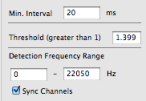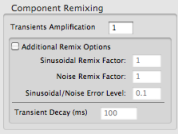- Zoom
Basic Settings
Detection Settings

The basic settings of the transient preservation include a time interval between transients, a detection threshold, and a frequency range.
A value in ms between two transients.
By default, the time is equal to 20 ms. A too short interval will yield several markers for the same transient.
A transient is correctly classified if the difference between the estimated start time is not superior to 50ms.
A ratio from 1 to 10.
This ratio is calculated from the relation between the global signal energy and the transient energy, or NEV[1].
The lower the ratio, the lower the detection sensibility is. A ratio of 1 would lead to confusion between residual noise and transients.
A ratio of 10 will probably yield no transients
Bandwidth in Hz.
This bandwidth can be defined freely by the user. By default, Flow = 0, Fhigh = Samplerate/2 (Nyquist Frequency), which are also the maximum frequency limits.
The evaluation of the energy variation and statistical model for background transient activity takes place in this frequency band.
This value is only operative for transient detections. Treatments requiring transients preservation and remix use the whole signal bandwith.
“Detection Frequency Range (between 0 and nyquist)” en Hz : détermine les limites fréquentielles pour les bandes utilisées par l'évaluation de la localisation normalisée de l'énergie et pour la détection (par défaut, fréquence minimale : 0Hz et fréquence maximale : fréquence de Nyquist).
fréquence de Nyquist = taux d'échantillonnage/2
Remarque : Cette valeur n'est prise en compte que pour la détection des transitoires. Pour les traitements (préservation et remixage des transitoires), la totalité de la bande du signal est utilisée.
This option allows to synchronize the channels of stereo sounds, and is not available for monophic sounds.
Components Remixing
These parameters handle the balance between stationnary components and transients. |  |
Check the option to access the following parameters :
Stationaries Amplification : a compensation factor for stationnary components
Transient Decay in ms : transients release duration
This is an amplitude compensation factor.
A 1.5 factor makes up for the amplitude loss due to the transients preservation algorithm.
A nil value will suppress the transients. A very high value, such as 2000, allows to get the transients only, provided the sound is normalized.
- NEV : Normalized Energy Variation
Maximum of the ratio between total signal energy and the transient energy over the whole duration of the onset.
